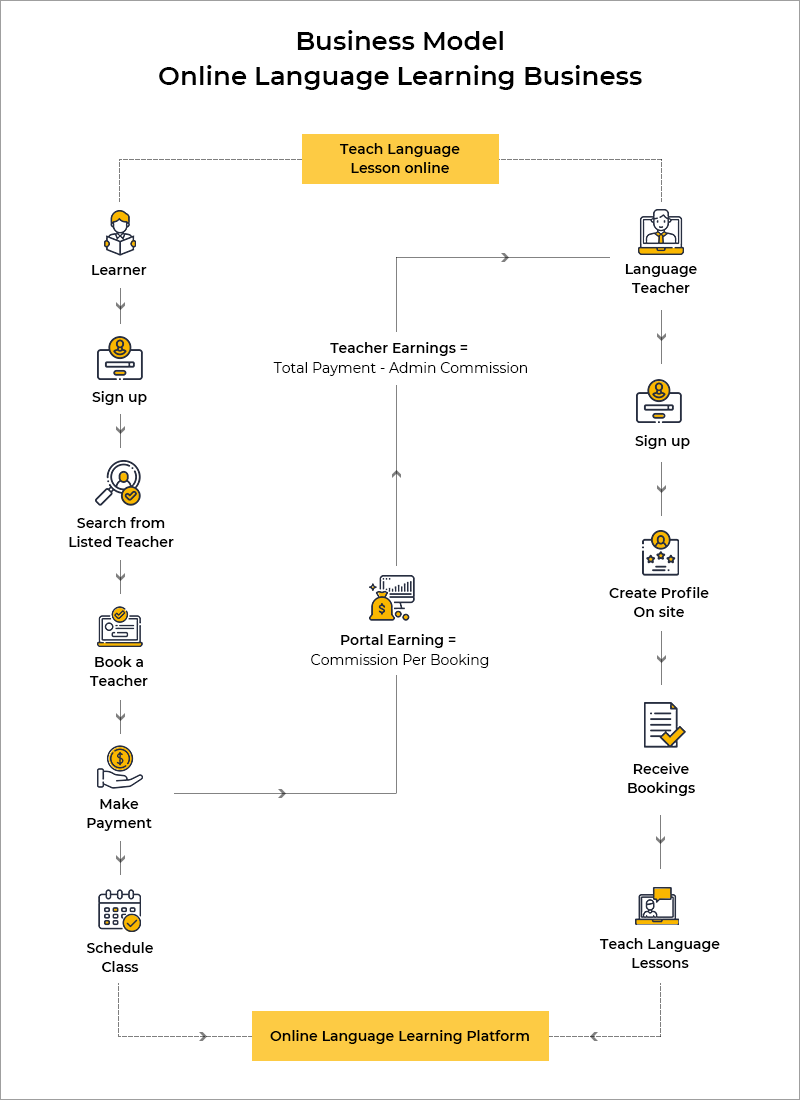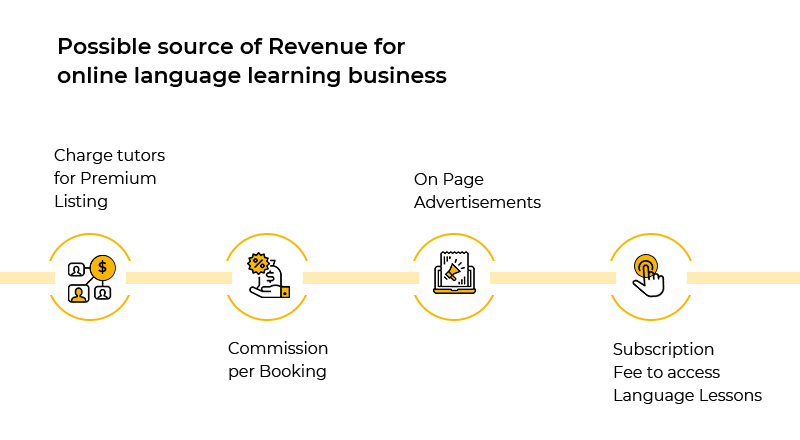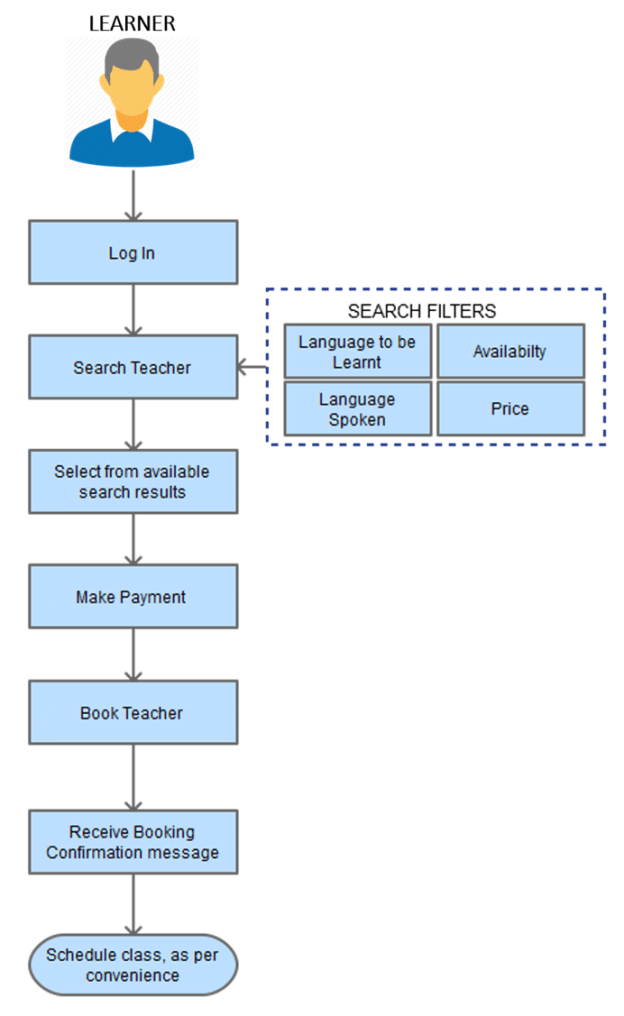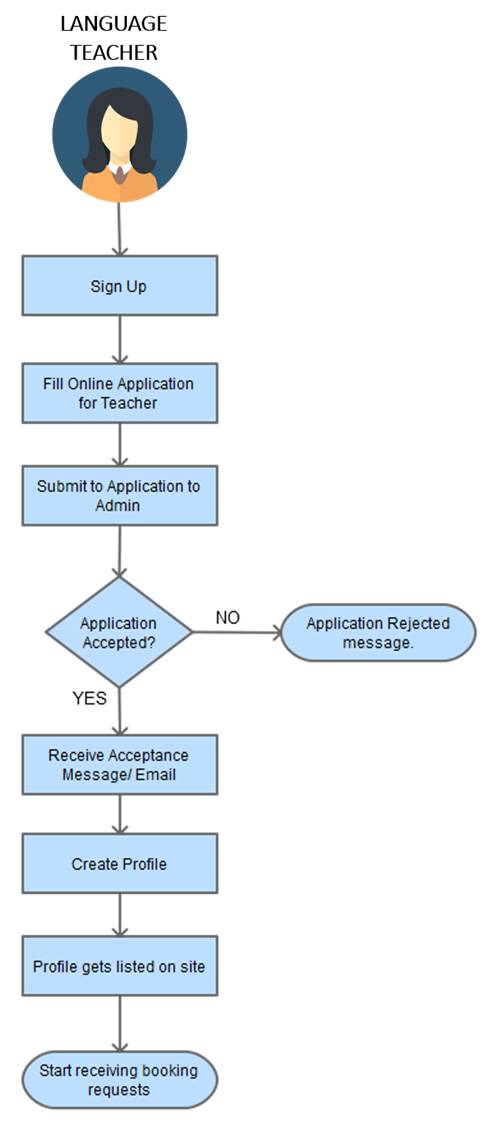The biggest barrier that people face
when learning a foreign language is the
lack of interaction with native
speakers. Social media platforms have bridged this gap to some extent in
the past few years but since the interaction is usually text-chat
based, they too aren't of much help when
it comes to building fluency in
a foreign language. Online language learning platforms like Verbling,
italki, Preply, Cambly, Livemocha, Babbel, Busuu, Memrise, Fluento , Mondly , LingQ, Anki,
HelloTalk and Lingoda answer this very need by offering audio/video chat with
native speakers.
These platforms are changing the way
people learn foreign languages. They help people across the world master
new languages by connecting
them with native speakers via live
audio/video chat. Learners can choose to join a group session or a
one-to-one private session as per their preference. FATbit's business
analysts, who always have a keen
eye for growing online businesses,
began an in-depth study of the working of these businesses to outline
the features required to make a language learning start-up stand apart.
Working of a Language Learning Website
A language learning marketplace has 3 main entities –
- The tutor creates a profile on the platform and a request is
sent to the admin for approval.
- The
admin after verifying all the information approves/disapproves the
profile. The approved profiles get listed on the platform.
- The
learner browses the platform for tutors using
filters such as
specialization, experience, price, language, and so on, and a list of
all the
relevant tutors is displayed.
- The learner then selects a tutor and checks his/her availability calendar for
the online session.
- After
making the payment, the learner then books a session with the tutor.
The payment of the lesson is however kept in the platform's escrow
account.
- Once the lesson is completed
successfully, the system releases the payment of the tutor after adjusting the commission.

Revenue
Generation Streams of Online Language Learning Platforms
As we studied the revenue generation
model of leading language learning portals,
we found that they are not
leveraging the full power of their platform and missing out on many
possible
revenue channels. We curated a list of all the possible revenue
channels so that new players can have an
advantage over the existing
ones.
-
A commission cut from the fee students pay to the tutors.
- A
monthly subscription for
students to access classes on the website out
of which a percentage will be distributed among the
tutors.
- Monthly subscription for tutors to feature, manage, and conduct their language learning courses on
the website
- On-site promotion for tutors
- Banner ads

Building an Online Language Learning Platform
Before actually starting to
build a
language learning platform, it is essential to keep in mind that the
design of the platform is
key to providing learners with the best
learning experience possible. It is not sufficient to develop
advanced
functionality, however, to fit that functionality into an intuitive user
interface and back it
up with an aesthetically pleasing user
experience. Below discussed are some points on how the prominent
pages
of the platform should be designed.
1.
Homepage
The homepage of a language
learning
website should have a simplified and intuitive design so that all the
offerings are conveyed in
an effortless manner. The best shot in this
context is an eye-catching and informative first-fold area that
allows
visitors to navigate the website further. Some suggestions on how the
home page should look
like:
- Place important links such as classes, tutors, signup, etc. in the top navigation bar.
- Put on a catchy website message in the website
banner.
- Use a background image in the banner to make the banner more attractive.
- Implement a Getting Started feature that asks
users which language they are fluent in and which
languages they want to learn leading them to the
signup page.
- The
section below the first fold can be used to feature popular language
learning classes,
top teachers, and testimonials of learners.
- Other than that, the footer area should feature quick links
to various content-based pages and social media handles.
2. Classes Page
As for the layout and design of the
Classes landing page, it should unlock a whole new range of
options for
learners. Below is a list of suggestions that you need to pay attention
to while designing
the classes page:
- The page right away should tell learners about the classes, their types, and
access level.
- Live sessions should be featured at the top of the page.
- Other classes (for private lessons) can be featured
below.
- There
should be an option to filter results based on the language they want
to learn, level
of difficulty, and tutor of their choice.
-
Classes
results should be featured with useful information such as class
name,
language, difficulty level, lesson description, tutor's name, and class
timings.
In addition to this, the language
learning platform should
support different types of classes. Here are
the most common types of language learning classes.
- Live Sessions:
Live online classes for the most popular languages that users can access but cannot join.
- Private Classes: Private sessions
that tutor and learner schedule beforehand.
- Class Recordings: Recordings of past sessions that can be accessed by learners once a tutor
provides them the access.
3. Tutors'
Page
This page will feature the tutors
listed on the website. Like the classes page, the tutors' page should
also list tutors with a brief
introduction and relevant filtering and
sorting options. Here are the elements that the tutors' page
shouldn't
miss:
- Filter tutor results based on the language they speak and teach, price, and
availability.
- Sorting options based on popularity and price.
- View general information about teachers like name, a short
introduction, rating, nationality, language expertise, etc.
- Options to visit tutor profiles, book demo class, and message
them.
In addition to this, a tutor profile page in a language learning
platform should offer detailed information about
the tutor helping learners make an informed decision while
choosing a
tutor. A tutor profile page should have elements somewhat similar to
this:
- Tutor's résumé
highlighting his/her career achievements.
-
Tutor's demo video.
- Tutor's general information like nationality, total
experience, overall rating, etc.
- Option to recommend the tutor to a friend via social media
(Facebook/Twitter/LinkedIn) or through email.
- Tutor's private lessons fee.
- Option to book lesson by the
tutor (trial/paid).
- Tutor's availability calendar to book a session.
- Tutor's reviews and ratings from
past students.
PROCESS FLOW DIAGRAM FOR BOOKING & SCHEDULING A
CLASS
4. Becoming a Tutor
The page of becoming a tutor on a language learning platform should be simple
consisting of the following elements:
-
Benefits of tutoring on the website
- Testimonials by existing tutors
- FAQ
section that addresses
general queries a user may have when becoming a
tutor; for instance, how tutors get paid, how to create
a class, etc.
- And, a registration form to apply to teach.
The registration form for becoming a tutor should accumulate the following details:
- Personal and contact
information
- Languages they want to teach
- A demo video
-
Professional experience and certifications
PROCESS FLOW DIAGRAM FOR LISTING ONESELF AS A LANGUAGE TEACHER ON AN ONLINE LANGUAGE LEARNING
PLATFORM
5. Learners' Page
The language learning platform should have the following value-added features for
the learners.
- A
dashboard to have a visual display of all the important links like
lessons (upcoming,
scheduled, unscheduled, canceled, completed,),
previous tutors, and much more at a glance.
- Students
should be able
to browse and search for the tutors as per their
requirements by applying various filters such as
language, price,
proficiency level, accent, experience, gender, etc.
- There should be an online wallet
for the students to make the process of purchasing lessons/Giftcards a hassle-free one.
- The students should be able to
mark their favorite teachers.
- Most
importantly, students should be able to edit/update their profile
information like personal information, avatar, email, password, and much
more.
Interactive Features for Effective Communication
Now that we have covered the working
and design of the prominent
pages of an online language learning
platform, let's list down a few interactive features that will make the
communication on the platform seamless.
- The platform must be equipped with an audio/video chat feature to enable the
tutors and students to see and interact with one
another. There are various third-party APIs to
integrate this
functionality in an online language learning platform.
- AtomChat: Replace traditional
language learning with a virtual classroom
experience by integrating
this optimized chat and video calling functionality.
- Lessonspace: Setting the new
normal for
top-quality video conferencing, this excellent API is
specifically designed to streamline remote
learning.
- Zoom: Built particularly for
virtual conversations, meetings, and conferences, Zoom provides ideal features for remote
communication.
- Language learning
becomes more enjoyable
if done in groups. Language learning platforms should include a shared
learning environment such as group discussions to prevent learners from feeling isolated.
- Language learning platforms
integrated with flashcards make it easy to review vocab, verbs, phrases, and grammar in exactly the same way the brain needs
for maximum memory retention.
- Screen sharing feature in online
language learning offers the flexibility to present, lessons,
assignments, learning materials to
everyone present in the online
classroom.
- Real-time translation of text messages helps the students and tutors save time and effort and enhances the
communication between them.
Essential Features to Stand Out From Competitors
There are some other impeccable
features that enable learners to get trained
in a versatile environment
and increase productivity to a greater extent. Let's discuss some of
them
in detail:
- Time-Zone Friendly: The platform
should be time-zone friendly to enable global users to
access the
platform as per their time zone. The tutors will be able to set their
availability
calendar as per their time zone which will be seen by the
learners in their own time zone sitting in
any other country. This
streamlines the coordination between the tutors and learners without any
fuss.
- Multilingual/Multicurrency: As
the language learning platform will have users from around the
world, it
is important to integrate the multilingual and multi currency features.
It allows the
users to be comfortable under their own skin, explore
more conveniently, and develop their
learning/teaching skills.
Localization features improve communication and clarity in learning,
eventually increasing the engagement rate.
- SEO Friendly: The best way to get
users to your
language learning platform is through a solid search
engine optimization strategy. It is essential
for the visibility of your
business, especially when you are part of a saturated market like
online language learning.
- Secure: Users these days are
exceedingly concerned about their privacy and
security which makes it
essential for the language learning platforms to comply with the GDPR
policies. Having a GDPR compliant platform builds the trust of the
customers over the platform
and improves the brand positioning.
- PWA: Users these days are burned
out by all the
necessary apps that are available in app stores. Having a
PWA of the language learning platform will
eliminate the hassle of
downloading the app from the app store. In reality, PWAs are web pages
that act like apps on mobile devices. They use offline push
notifications and can be added to
the homepage on mobile devices.
Closing Thoughts
Building
a unique language learning
portal requires in-depth planning about key features. There is no need
to
compete with the already existing language learning businesses like
Verbling, as they are already
established in the market. All a new
business needs to do is discover the untapped potential and create
a
solution for it. The best solution is to come up with an MVP and
validate the business idea. This
is where Yo!Coach can come into play.
Yo!Coach enables
entrepreneurs to build an online language learning
platform with all the advanced features mentioned above. The
software is open to
customizations and can be tailored as per the business requirements.
Its live
demo is also available to get a hands-on experience.



